© Copyright Atlanta Coin Expositions, 2008-2025. All Rights Reserved.
Several of the links on the pages within this web site go to affiliate vendors.
A vendor affiliation can mean a small monetary compensation to the web site owner at no additional cost to you.
Several of the links on the pages within this web site go to affiliate vendors.
A vendor affiliation can mean a small monetary compensation to the web site owner at no additional cost to you.
Coin Show
Information
Shop
General
Coin Show - Monthly Notes from June 2018
Next Monthly Coin Show
These few graded coins are just a small sampling of the treasures on the bourse.
In addition to certified (graded) coins, many dealers also offer coins in 2x2 holders with a variety of values and grades for the fun of the treasure hunt.
The coins represent a broad sampling of mintage years from the early to the modern, plus ancient coins and world coins can also be found.
The many dealers on the bourse represent an assortment of collecting interests and bring to each show specimens that intrigue a wide range of treasure hunters.
Mark your calendars for the next Greater Atlanta Coin Show on Sunday, July 15, 2018, in the Joe Mack Wilson ballroom on the main conference area.
In addition to certified (graded) coins, many dealers also offer coins in 2x2 holders with a variety of values and grades for the fun of the treasure hunt.
The coins represent a broad sampling of mintage years from the early to the modern, plus ancient coins and world coins can also be found.
The many dealers on the bourse represent an assortment of collecting interests and bring to each show specimens that intrigue a wide range of treasure hunters.
Mark your calendars for the next Greater Atlanta Coin Show on Sunday, July 15, 2018, in the Joe Mack Wilson ballroom on the main conference area.
Welcome and thank you to the many visitors who came to the June 2018 Greater Atlanta Coin Show.
We appreciate all of you from the visitors to the dealers to the security and to the hotel's staff who help make the coin show a success each month.
For June, we had several visiting dealers as some of our regulars had schedule conflicts - a big welcome to each of you and we hope you enjoyed the show.
The weather was beautiful with the early morning in the pleasant, low 70s and the afternoon temperatures approaching the hot range.
We appreciate all of you from the visitors to the dealers to the security and to the hotel's staff who help make the coin show a success each month.
For June, we had several visiting dealers as some of our regulars had schedule conflicts - a big welcome to each of you and we hope you enjoyed the show.
The weather was beautiful with the early morning in the pleasant, low 70s and the afternoon temperatures approaching the hot range.
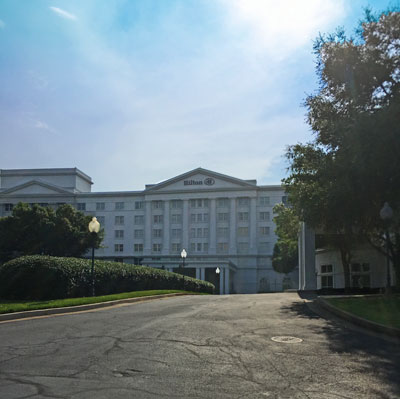
By the calendar, summer has not arrived, but the humidity and temperatures provide us with glimpses into what to expect.
This month, the hotel did not have quite as much activity, however we saw many young people in baseball uniforms - perhaps for a tournament in the area.
On the bourse, several collections arrived wanting evaluations with the potential to sell, one of which approached the six-digit range.
On the flip-side visitors also wanted to buy quantities of gold and silver, both coins and, in the case of silver, rounds and bars.
That's not all, some visitors were interested in paper money as well, both buying and selling.
Of course, many of our visitors come to see the many different collectibles on the bourse with the hope to find a treasure that interests them.
Let's take a quick look at a few items at this month's coin show.
This month, the hotel did not have quite as much activity, however we saw many young people in baseball uniforms - perhaps for a tournament in the area.
On the bourse, several collections arrived wanting evaluations with the potential to sell, one of which approached the six-digit range.
On the flip-side visitors also wanted to buy quantities of gold and silver, both coins and, in the case of silver, rounds and bars.
That's not all, some visitors were interested in paper money as well, both buying and selling.
Of course, many of our visitors come to see the many different collectibles on the bourse with the hope to find a treasure that interests them.
Let's take a quick look at a few items at this month's coin show.
Cannon
Well, this first item was not on the bourse, but it's an interesting display nevertheless.
Frequently, we give directions such as "near the cannon," "go past the cannon," or "turn left (or right) at the cannon" to name a few.
There are probably people who question, "What cannon? Why would a hotel have a cannon?"
The hotel happens to be located on the grounds that used to be the Georgia Military Institute.
The hotel provides this information about the area and the cannon:
Frequently, we give directions such as "near the cannon," "go past the cannon," or "turn left (or right) at the cannon" to name a few.
There are probably people who question, "What cannon? Why would a hotel have a cannon?"
The hotel happens to be located on the grounds that used to be the Georgia Military Institute.
The hotel provides this information about the area and the cannon:
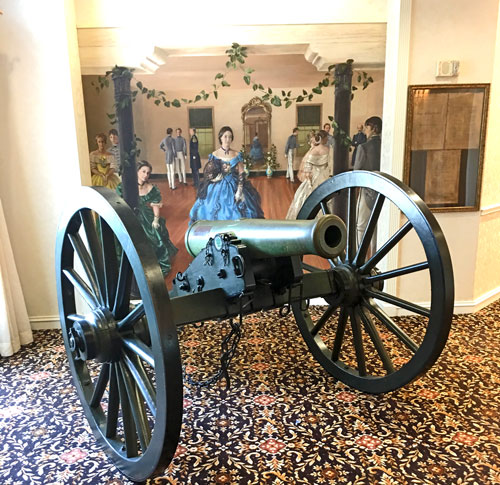

"Established in Marietta and opened to students in 1851, the Georgia Military Institute (GMI) was the principal source of education for new engineers and teachers in the state during the decade prior to the Civil War (1861-65).
"Originally funded by private subscription and donations, GMI began its official relationship with the state in 1852, when the legislature chartered the school and presented it with muskets, swords, and a battery of four cannons.
"Although GMI began with only three instructors and seven students, it quickly attracted a large number of cadets from Georgia's wealthiest families. Between 1853 and 1861, GMI's student body fluctuated between 150 and 200 cadets.
"GMI's 110-acre campus included a parade ground, an academic building, four student barracks, and a residence for the school superintendent, Brumby Hall, which is still standing today and available for tours and private events.
"Like most southern military schools of the late antebellum period, GMI based its curriculum on the course of study at the U.S. Military Academy at West Point, New York.
"Originally funded by private subscription and donations, GMI began its official relationship with the state in 1852, when the legislature chartered the school and presented it with muskets, swords, and a battery of four cannons.
"Although GMI began with only three instructors and seven students, it quickly attracted a large number of cadets from Georgia's wealthiest families. Between 1853 and 1861, GMI's student body fluctuated between 150 and 200 cadets.
"GMI's 110-acre campus included a parade ground, an academic building, four student barracks, and a residence for the school superintendent, Brumby Hall, which is still standing today and available for tours and private events.
"Like most southern military schools of the late antebellum period, GMI based its curriculum on the course of study at the U.S. Military Academy at West Point, New York.
"Located on Powder Springs road just outside of Marietta, GMI cadets would perform drills each afternoon. It was a local attraction for the town folks to stroll down to the Institute and admire the precision of the cadets.
"Located behind the campus is Lost Mountain and Kennesaw Mountain where later many Confederate Soldiers would die in defense of the South.
"Located behind the campus is Lost Mountain and Kennesaw Mountain where later many Confederate Soldiers would die in defense of the South.
"The cadets utilized two brass cannons during these drills. These cannons were utilized during Civil War and today one cannon is located in the lobby of the Hilton Marietta Hotel &Conference Center (previous site of GMI) and the other cannon is located at the Confederate Cemetery in Marietta, directly across from the Hotel.
"An exhibit of GMI is located in the Marietta Museum of History in the Old Kennesaw House in the Marietta Square. Many artifacts from the Georgia Military Institute can be viewed there."
Each time you visit the coin show, you visit an historical area.
"An exhibit of GMI is located in the Marietta Museum of History in the Old Kennesaw House in the Marietta Square. Many artifacts from the Georgia Military Institute can be viewed there."
Each time you visit the coin show, you visit an historical area.
Buffalo or Indian Head Nickel Coins
A group of beautiful Buffalo or Indian Head Nickels caught our interest on this month's bourse.
Each of these happens to be graded by PCGS (Professional Coin Grading Service) as Proof-66.
Starting at Proof-60 and going through Proof-70, there are eleven Proof grades.
The Official American Numismatic Grading Standards for United States Coins describes the Proof-66 grade as:
Each of these happens to be graded by PCGS (Professional Coin Grading Service) as Proof-66.
Starting at Proof-60 and going through Proof-70, there are eleven Proof grades.
The Official American Numismatic Grading Standards for United States Coins describes the Proof-66 grade as:
"Has above average quality of strike and full mirror (or other style Proof) surface, with no more than two or three minor but noticeable contact marks. A few light hairlines may show under magnification, or there may be one or two light scuff marks showing on frosted surfaces or in the field. The eye appeal is above average and very pleasing for the variety.
"Contact Marks: Several small; a few may be in prime focal areas. Hairlines: None visible without magnification. Fields: Above average. Fully original. Eye Appeal: Above average."
Let's look at each of the examples [NOTE: Price Guide Quotes for the following are as of June 2018]:
"Contact Marks: Several small; a few may be in prime focal areas. Hairlines: None visible without magnification. Fields: Above average. Fully original. Eye Appeal: Above average."
Let's look at each of the examples [NOTE: Price Guide Quotes for the following are as of June 2018]:
1913 Type 1 Buffalo Nickel
From Ron Guth on the PCGS CoinFacts: "In 1913, the new Buffalo Nickel appeared to enthusiastic reception from the public. The Mint made the normal strikes for circulation and Proofs for sale to collectors. Proof Buffalo Nickels were given the matte finish that first appeared on Lincoln Cents in 1909, which was a dramatic change from the brilliant Proofs of previous years. The matte finish is definitely an acquired taste, because it is not dramatically different, at first glance, from a normal circulation strike. However, a well-made matte Proof has crisp details, mark-free surfaces, and a sharply-squared border. "
The US Mint produced 1520 of the proof 1913 Type 1 Buffalo Nickel in Philadelphia. PCGS estimates the survival at 900 coins.
To date, they have graded 395 of the proof coins ranging from PR-62 through PR-68 with 133 as PR-66.
Similarly, NGC (Numismatic Guaranty Corporation) has graded 307 also ranging from PR-62 through PR-68 with 101 as PR-66.
The Type 1 version of the 1913 Buffalo Nickel shows the bison on the reverse standing on a mound with the words "FIVE CENTS" over the mound.
For the PR-66 1913 Type 1 Buffalo Nickel, the PCGS Price Guide shows $4750 whereas the NGC Price Guide shows $4700.
The US Mint produced 1520 of the proof 1913 Type 1 Buffalo Nickel in Philadelphia. PCGS estimates the survival at 900 coins.
To date, they have graded 395 of the proof coins ranging from PR-62 through PR-68 with 133 as PR-66.
Similarly, NGC (Numismatic Guaranty Corporation) has graded 307 also ranging from PR-62 through PR-68 with 101 as PR-66.
The Type 1 version of the 1913 Buffalo Nickel shows the bison on the reverse standing on a mound with the words "FIVE CENTS" over the mound.
For the PR-66 1913 Type 1 Buffalo Nickel, the PCGS Price Guide shows $4750 whereas the NGC Price Guide shows $4700.

1913 Type 2 Buffalo Nickel
This next coin is also a 1913 but a Type 2 variety of which the US Mint's Philadelphia location struck 1514 of the proof coins.
For this version, PCGS estimates 950 of the coins have survived the last 105 years.
They have graded 384 of the coins as PR-62 through PR-68 with 110 as PR-66.
NGC has graded 237 as PR-61 through PR-68 with 73 as PR-66.
The Type 2 version of the coin still has the bison standing on a mound, however the mound has a defined bottom with the words "FIVE CENTS" showing below the line under the mound.
For the PR-66 Type 2 of the 1913 Buffalo Nickel, the prices guides show $2500 for PCGS and $3450 for NGC.
For this version, PCGS estimates 950 of the coins have survived the last 105 years.
They have graded 384 of the coins as PR-62 through PR-68 with 110 as PR-66.
NGC has graded 237 as PR-61 through PR-68 with 73 as PR-66.
The Type 2 version of the coin still has the bison standing on a mound, however the mound has a defined bottom with the words "FIVE CENTS" showing below the line under the mound.
For the PR-66 Type 2 of the 1913 Buffalo Nickel, the prices guides show $2500 for PCGS and $3450 for NGC.
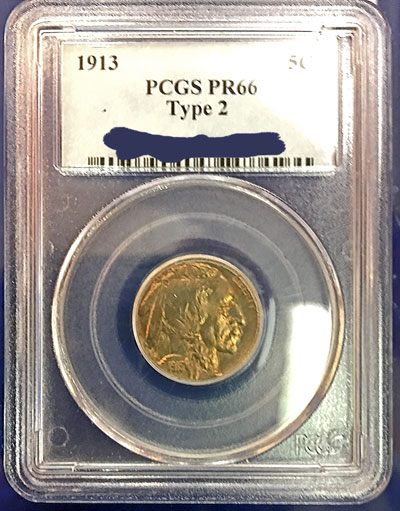
1914 Buffalo Nickel
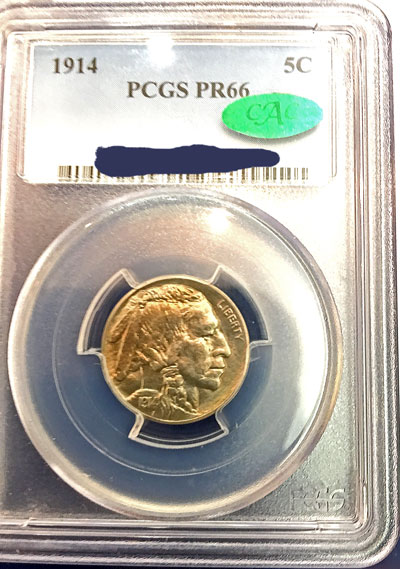
In sequence, the US Mint produced 1275 of the 1914 proof Buffalo Nickel coins.
Per Jaime Hernandez from the PCGS CoinFacts, "The 1914 Proof Buffalo Nickel has the third lowest mintage in the series. Just under 1,300 examples were struck. Overall, few Proof Buffalo Nickels were produced since they were only struck for six years, therefore, making them scarce. Examples up to about PR67 condition appear in the market regularly that most collectors can find one with minimal effort. In PR68 condition it is a different story, as few examples exist. It may take many years before one appears in the market, so collectors cannot be too picky when it comes to finding a PR68 example.
PCGS estimates 1050 or roughly 82% of the 1914 proof nickels still exist.
They have graded 540 specimens from PR-62 through PR-68 with 149 in the PR-66 grade.
NGC has graded 418 of the proof coins from PR-62 through PR-68 with 124 at PR-66.
Their price guides show $2700 for NGC and $2750 for PCGS.
Per Jaime Hernandez from the PCGS CoinFacts, "The 1914 Proof Buffalo Nickel has the third lowest mintage in the series. Just under 1,300 examples were struck. Overall, few Proof Buffalo Nickels were produced since they were only struck for six years, therefore, making them scarce. Examples up to about PR67 condition appear in the market regularly that most collectors can find one with minimal effort. In PR68 condition it is a different story, as few examples exist. It may take many years before one appears in the market, so collectors cannot be too picky when it comes to finding a PR68 example.
PCGS estimates 1050 or roughly 82% of the 1914 proof nickels still exist.
They have graded 540 specimens from PR-62 through PR-68 with 149 in the PR-66 grade.
NGC has graded 418 of the proof coins from PR-62 through PR-68 with 124 at PR-66.
Their price guides show $2700 for NGC and $2750 for PCGS.
1915 Buffalo Nickel

In 1915, the Philadelphia mint struck 1050 of the proof five-cent coins.
Per Jaime Hernandez on the PCGS CoinFacts, "The 1915 Proof Buffalo Nickel has the second lowest mintage in the series. Most examples that exist appear to be in PR65 to PR66 condition. Examples grading PR67 are considered scarce. Anything grading PR68 or higher is rare and probably a handful or two, at most, exist in this condition."
They estimate 875 of the coins have survived out of the original minted proof coins.
PCGS has graded 453 in the PR-62 to PR-68 range with 154 of those as PR-66.
Similarly, NGC has graded 351 from PR-60 through PR-69 with 94 as PR-66.
The prices guides for the PR-66 1915 Buffalo Nickel show $2800 for NGC and $2200 for PCGS.
Per Jaime Hernandez on the PCGS CoinFacts, "The 1915 Proof Buffalo Nickel has the second lowest mintage in the series. Most examples that exist appear to be in PR65 to PR66 condition. Examples grading PR67 are considered scarce. Anything grading PR68 or higher is rare and probably a handful or two, at most, exist in this condition."
They estimate 875 of the coins have survived out of the original minted proof coins.
PCGS has graded 453 in the PR-62 to PR-68 range with 154 of those as PR-66.
Similarly, NGC has graded 351 from PR-60 through PR-69 with 94 as PR-66.
The prices guides for the PR-66 1915 Buffalo Nickel show $2800 for NGC and $2200 for PCGS.
1916 Buffalo Nickel
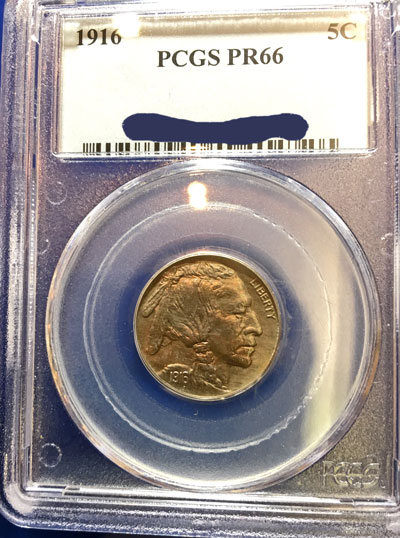
Still in sequence, Philadelphia produced just 600 of the 1916 five-cent proof coin.
Oddly, though, PCGS CoinFacts estimates 525 of the original 600 still exist.
They have graded 287 in the PR-63 through PR-68 grades with 103 as PR-66 and even show one in a "58" grade.
NGC shows they have graded 171 in the PR-64 through PR-68 ranges with 52 in PR-66.
Per their price guides, PCGS shows a value of $5250 while NGC shows $5200 for the PR-66 1916 five-cent coin.
NGC also notes: "The 1916 proof nickel is perhaps the epitome of the Type 2 design, as the Mint strengthened the word LIBERTY, a feature that had always been deficient, even on proofs. It should have taken such care in engraving the final numeral of the date, as the 6 is clearly taller than the other figures."
Oddly, though, PCGS CoinFacts estimates 525 of the original 600 still exist.
They have graded 287 in the PR-63 through PR-68 grades with 103 as PR-66 and even show one in a "58" grade.
NGC shows they have graded 171 in the PR-64 through PR-68 ranges with 52 in PR-66.
Per their price guides, PCGS shows a value of $5250 while NGC shows $5200 for the PR-66 1916 five-cent coin.
NGC also notes: "The 1916 proof nickel is perhaps the epitome of the Type 2 design, as the Mint strengthened the word LIBERTY, a feature that had always been deficient, even on proofs. It should have taken such care in engraving the final numeral of the date, as the 6 is clearly taller than the other figures."
1937 Buffalo Nickel

The next proof in this series on the bourse was the 1937 Buffalo Nickel, though the US Mint did also produce a proof in 1936 in both Satin and Brilliant versions.
From PCGS CoinFacts, they estimate 5000 of the 5769 originally minted 1937 five-cent proof coins have survived.
They have graded 2573 1937 proof nickels from PR-60 through PR-69 with 849 as PR-66 and with one additional as a "58" grade.
NGC, on the other hand, has grade 1614 as proof and 8 as proof-cameo with 499 as PR-66 and 2 as PR-66 Cameo.
In their price guides, PCGS shows the 1937 PR-66 as $1350 while NGC shows $1600.
From PCGS CoinFacts, they estimate 5000 of the 5769 originally minted 1937 five-cent proof coins have survived.
They have graded 2573 1937 proof nickels from PR-60 through PR-69 with 849 as PR-66 and with one additional as a "58" grade.
NGC, on the other hand, has grade 1614 as proof and 8 as proof-cameo with 499 as PR-66 and 2 as PR-66 Cameo.
In their price guides, PCGS shows the 1937 PR-66 as $1350 while NGC shows $1600.
1893-S Morgan Dollar

Last on our list for June is a 1893-S Morgan Dollar graded as VF-35.
The US Mint's San Francisco location produced 100,000 of these Morgan dollar coins, one of the lowest mintages of these dollars across all mint locations for the Morgan years.
Per David Hall:
"The 1893-S is the true 'King' of the Morgan dollar series. The PCGS CoinFacts Board of experts estimated survival number for all grades is 9948. Dave Bowers has estimated that 6000 to 12,000 survive and I think those numbers are probably accurate. There are probably as many as 10,000 1893-S dollars in all grades.
"In Mint State condition, the 1893-S is absolutely the rarest Morgan dollar. And in Gem MS65 or better it's a super rare coin. CoinFacts survival estimate is 123 Mint State survivors and 18 MS65 or better survivors. I believe that MS65ob number is way too high. I think there may very well be 100 or so MS60ob survivors, but no way is there 18 Gems. I believe the true number of MS65 or better examples is probably 6 to 7 coins.
"The finest known example is the fabulous Jack Lee MS67, recently sold for over a million dollars. There are 5 or 6 others that have or would grade MS65 at PCGS. Over the years I have handled several Gems, but if there were truly more than 10 MS65ob coins then they would appear much more often than they do.
"Note that this is one Morgan that is virtually unknown in prooflike condition.
"Note that there are many counterfeits, usually made by adding an "S" to a 1893 Philadelphia. So authentication is highly recommended.
The US Mint's San Francisco location produced 100,000 of these Morgan dollar coins, one of the lowest mintages of these dollars across all mint locations for the Morgan years.
Per David Hall:
"The 1893-S is the true 'King' of the Morgan dollar series. The PCGS CoinFacts Board of experts estimated survival number for all grades is 9948. Dave Bowers has estimated that 6000 to 12,000 survive and I think those numbers are probably accurate. There are probably as many as 10,000 1893-S dollars in all grades.
"In Mint State condition, the 1893-S is absolutely the rarest Morgan dollar. And in Gem MS65 or better it's a super rare coin. CoinFacts survival estimate is 123 Mint State survivors and 18 MS65 or better survivors. I believe that MS65ob number is way too high. I think there may very well be 100 or so MS60ob survivors, but no way is there 18 Gems. I believe the true number of MS65 or better examples is probably 6 to 7 coins.
"The finest known example is the fabulous Jack Lee MS67, recently sold for over a million dollars. There are 5 or 6 others that have or would grade MS65 at PCGS. Over the years I have handled several Gems, but if there were truly more than 10 MS65ob coins then they would appear much more often than they do.
"Note that this is one Morgan that is virtually unknown in prooflike condition.
"Note that there are many counterfeits, usually made by adding an "S" to a 1893 Philadelphia. So authentication is highly recommended.
Of the PCGS estimated 9948 surviving 1893-S Morgan dollars, they have graded 364 as VF-35 with a projected value of $6350.
Of course, across all of these graded coins, the price guides are just that - guides. For graded coins, there are nuances within the same grade that will yield different values with "eye appeal" being a big component.
Of course, across all of these graded coins, the price guides are just that - guides. For graded coins, there are nuances within the same grade that will yield different values with "eye appeal" being a big component.

